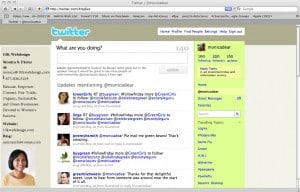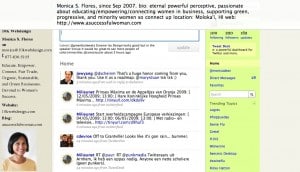You’ve either just started your Twitter account or you’re thinking about taking the plunge for your business.
You might have been reading about the incredible ability of the Search function on Twitter to find real-time, individual conversations about the keywords that you’re passionate about: search.twitter.com.
For this tool, along with all others, consider: what are you doing with social networking?
Do you have a plan for integrating this tool into your marketing efforts?
Are you willing to spend the time, or hire out, to maintain your Twitter profile?
What part of your business is web-driven. Do you provide timely content that would benefit from “re-tweeting”?
If no, your account will most probably fall by the wayside, like the up to 60% of other Twitterers who leave their accounts within the month, out of frustration or befuddlement.
How to do it right: a great example of Twitter usage is Hugh Jackman, who posted on April 14 that he would donate $100,000 to a nonprofit: “I will donate 100K to one individual’s favorite non profit organization.Of course,you must convince me why by using 140 characters or less”.
By April 24th he had decided, donating to Charity Water and Operation of Hope. He also raised over 180,000 followers, opening a direct communication to his fans (just in time for Wolverine’s opening) on May 1.
There are, of course, other celebrity examples (Oprah, Ashton, Demi) but I leave you with my best example of using Twitter: getting up-to-date news during the October 2007 San Diego wildfires.
At a time when traditional media channels were slow, news websites were crashing, and cellphones were busy or full, Twitter (@KPBSNews) provided up-to-the-minute, region-specific reporting on road closures, wind conditions, containment and what to do. This helped me connect with loved ones, family, and friends to figure out what was happening and what to do, in real time.
I believe Twitter will help your business by helping you connect with like-minded people.
Here are 20 of my tips on using Twitter:
1) Twitter is comprised of 140-character updates.
It’s an excellent way to connect with other people who are interested in the same things you are. It is also an excellent way to have a search-engine friendly “micro-blogging” tool. It is free and easy to use.
2) Following.
The difference between Twitter and Facebook is that you may “follow” someone else, but they don’t have to “follow” you back. (In Facebook, when you “friend” someone, they automatically “friend” you back.)
The difference between Twitter and LinkedIn is that Twitter is more of a blend between personal, social, and business, and can be more anonymous/username driven, while LinkedIn is business-related, formal, and connected (you use your real name, and you know a connection, or you know them through someone else).
3) Twitter is a conversation.
Twitter is a way to connect with other people. Treat it as such. Refrain from being to “sales-y” or worse, connecting with no one, only talking about yourself, or marketing yourself as a Twitter expert.
4) The homepage.
When you login within Twitter, you may also “follow” anyone else: such as a person, organization, brand, or company. Anyone may “follow” your account, which means your postings show up on their homepage.
5) To begin, set up your account.
http://www.twitter.com
Your username such as a shortened version of your business website, or your own name will be good. Note that the “handle” is usually @somethinglikeyourname, so for example, I am @monicadear and found here: http://www.twitter.com/monicadear.
The number of characters in your handle counts towards your total of 140 characters, so make it short if you can!
6) Reserve your account names.
You may consider “storing” versions of your long name (e.g. I have also reserved my full name and I point people back to my active account) as well as your company name (we have another Twitter account that’s only company-related).
Your Twitter homepage is http://www.twitter.com/youraccountname
7) Settings.
Once you’re logged in, go to the “settings” page to set up your website URL link and your bio.
http://twitter.com/account/settings
Do you want to get an e-mail notification whenever someone starts following you?
Set your notifications here:
http://twitter.com/account/notifications
Upload a photo of yourself to personalize your page.
http://twitter.com/account/picture
Use Twitbacks.com if you’d like a free way to personalize your background. Or, ask your graphic designer to customize your background.
http://twitter.com/account/profile_settings
8) Time to start finding other people.
Go to: http://search.twitter.com and type in your key phrases. Mine are minority women business and here are the results for that search: http://search.twitter.com/search?q=minority+women+business. Try the search on your own keywords (like your industry, your interests and hobbies, your business specialization, etc.)
Click on anyone’s name to see their profile page.
9) What to post?
You’ll notice that most new Twitter postings start out with regular status updates (like what someone ate for lunch, where they’re commuting to in their car, if they’re at the airport). This is a fairly typical starting point: most first posts by Twitterers have these mundane items.
What’s better is to start posting directly and specifically on your key phrases and asking questions, connecting, and networking based on your interests.
10) When you click on any Twitter username, you land at their profile page.
For example, this blog, Women on Business is run by www.twitter.com/susangunelius
You may click the “Follow” button under the name to start “following” that person’s updates. If they have the option set up on their own profile, they’ll receive an e-mail that you started following them.
11) Connecting.
As you start to find people you like or if you’re looking to connect with others, you may use the “What are you doing” box to send that person a message. You do so by adding an @ in front of their name, and then sending a message (within the 140 character limit). So, for example, on your homepage, to send me a message, you would write:
@monicadear Here is my message from the WomenonBusiness.com website!
12) Your username in the Twittersphere.
If anyone writes you in their message, you may see the “mentions” by clicking on the @username link on your right-hand sidebar:

(click for larger version of picture)
13) Tagging others.
You may tag multiple people in your message, such as:
@susangunelius @monicadear I love http://www.WomenonBusiness.com It’s such a fantastic resource.
Then, all the people with the @ sign will receive the mention of your message.
14) Direct messaging.
Now that you’re connecting with people, some may “follow” you back. If so, you may “DM” or direct message them. You do this by typing into your box:
dm monicadear this is a direct message to Monica to say how much I enjoy Twitter
A direct message is more like a personal e-mail and doesn’t show up in the “twitterstream” of items on your homepage. It shows up in the “Direct Messages” folder on your Twitter homepage.
You receive an e-mail if someone direct messages you, if you’ve turned “on” that notification in your profile settings | notifications page.
15) Trending.
Trending topics, meaning “mentions” of a topic, now show on the right hand sidebar. To comment on a topic, you add the hash tag and the one word name of the topic, like so:
#weather or #traffic
Twitter is a source of immediate information on many topics. The search engine within Twitter is now also starting to check regular words and phrases, so the hashtag solution may start reducing in importance.
16) Set-aside codes.
There are some interesting set-aside codes in the Twitter “What are you doing” box that may be helpful.
For example, write: whois username, where username is the Twitter username, click update, and you’ll receive a brief summary of that person:
whois monicadear gives you these results:

(click for larger version of picture)
17) Advanced search.
In search.twitter.com, you may use the Advanced Search features to find posts on a specific topic or keyword, or by a specific person.
You could also use the following codes:
near: to find any tweets posted near a particular city, such as
fashion near:Los+Angeles
or within: to find any tweets posted within a certain radius of you, such as:
women in business within:15mi
18) Quality versus Quantity.
Everyone wants more Twitter followers, it’s a fact.
That said, it’s my belief that you will reach more people, and be more effective and spreading your message, by building real relationships with others. This is social networking, after all. Give me one good friend, or give me ten good-hearted and kind individuals who connect, communicate, and care — I don’t need a thousand people who don’t care and won’t do anything when I ask them for help.
Now, I *do* want ten thousand people who will help spread my message of encouraging women in business, especially minority women.
19) Realtime communications.
Twitter is an excellent place to get immediate feedback, kick around ideas, and receive answers to your questions… right now.
Consider it like a search engine on real people in real time with real responses, immediately. Businesses have been using it to post Twitter-only deals, to connect and provide a “voice” to the consumer, to answer customer complaints, and to give news as it happens.
For my web design business we typically embed the latest tweets into our clients’ website pages. You can find more about widgets and badges here:
http://twitter.zendesk.com/forums/10711/entries/15354
20) Different ways to access your account.
Many Twitter users migrate to a different application or platform (phone, Blackberry) to manage their tweeting instead of logging on to the Twitter.com website directly.
For example, I periodically use this installed application to manage my “tweets”.
TweetDeck.com
Mac and iPhone users may consider Twitterrific.
Twitpic allows you to share photos directly to Twitter.
I also use Twitterfeed.com, which takes posts from your blog and automatically “feed” them to your Twitter account.
Twitterholic.com shows you the numbers of users following top-ranked accounts.
You can see many more applications here: http://twitter.com/downloads.
Some people use Twitter to update their Facebook status (which may be helpful to you, if you don’t regularly log in to Facebook).
I hope this introduction was helpful. You may also see some tips on using Facebook for business and LinkedIn for business.
If you’re looking for a connection, come and follow me! http://www.twitter.com/monicadear and tweet me @monicadear a little bit about your business or venture. I’d love to connect.



